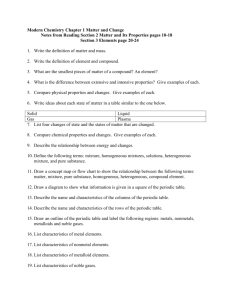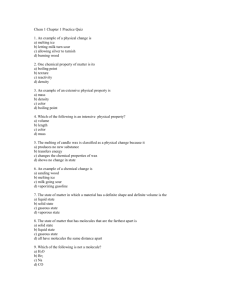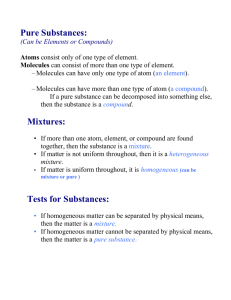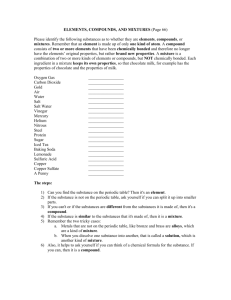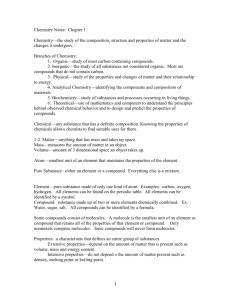1000-1
advertisement
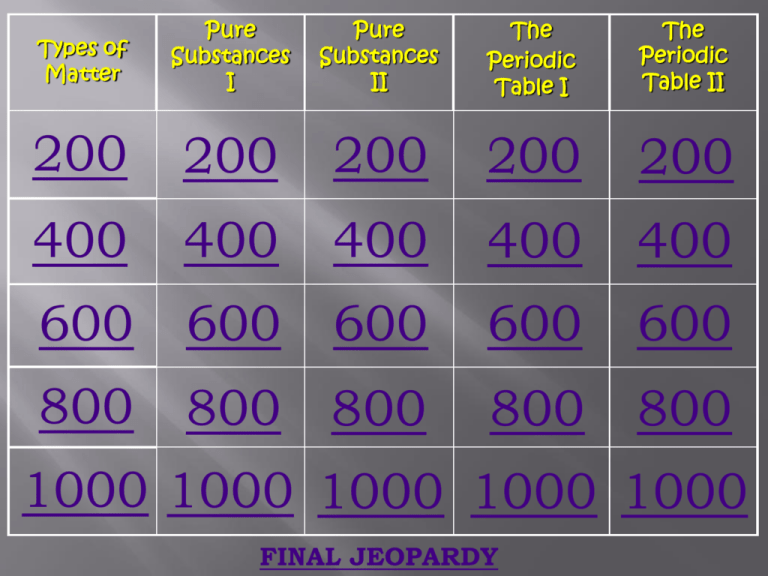
Types of Matter Pure Substances I Pure Substances II The Periodic Table I The Periodic Table II 200 200 200 200 200 400 400 400 400 400 600 600 600 600 600 800 800 800 800 800 1000 1000 1000 1000 1000 FINAL JEOPARDY 200-1 What is the difference between a mixture and a pure substance? A mixture can be physically separated into its individual parts, a pure substance cannot be physically separated into its individual parts. 400-1 What is the difference between a heterogeneous and a homogeneous mixture? A heterogeneous mixture is made of visibly different substances. A homogeneous mixture appears to be uniform, or the same, throughout the mixture. 600-1 What is an example of a heterogeneous mixture? Sand, rocks and marbles, oil and vinegar (salad dressing) 800-1 What is an example of a homogeneous mixture? Any solution; steel 1000-1 What type of homogenous mixture is made of at least two substances in which the particles of the substances are completely and evenly mixed together? Give an example. A solution. Examples: salt water, juice, soda, kool-aid, etc. 200-2 What are the two kinds of pure substances? Elements and compounds 400-2 What type of pure substance cannot be broken down into any other substances by chemical or physical means? An element 600-2 What are the three types of elements? Metals, nonmetals and metalloids 800-2 Give an example of a metal and give an example of a nonmetal. Where can you find the metalloids on the periodic table? Examples of metals are found on the left side of the periodic table up to group 14. Examples of nonmetals are found on the right side of the periodic table from groups 15-18. Metalloids are found on the diagonal barrier between metals and nonmetals from groups 1316. 1000-2 Name at least two differences between metals and nonmetals. Metals lustrous (shiny); nonmetals appear dull. Metals are malleable and ductile (able to change shape without breaking); Nonmetals are brittle (break when their shape is changed). Metals are good conductors of heat and electricity; nonmetals are poor conductors of heat and electricity. 200-3 What type of pure substance is made of two or more elements which have been chemically combined? A compound 400-3 Is O2 a compound or an element? Why? O2 is an element because the formula only contains one element. 600-3 Is H2O a compound or an element? Why? H2O is a compound because the formula contains two elements. 800-3 How is a compound different from a mixture? A compound cannot be physically (easily) separated into its elements. A mixture can be physically (easily) separated into its parts. 1000-3 How do the properties of a compound compare to the properties of the elements which make up the compound? The properties of a compound are different from the properties of the elements which make up the compound. For example, oxygen and hydrogen are both gases at room temperature, but combined, they form water which is a liquid at room temperature. 200-4 What element is represented by the symbol Sn? Tin 400-4 What are the rows of the periodic table called and how many are there? What are the columns of the periodic table called and how many are there? Rows = Periods – 7 Columns = Groups or families – 18 600-4 What is the difference between CO and Co? CO is the compound called carbon monoxide. It is made of one carbon atom and one oxygen atom. Co is an element called cobalt. 800-4 Does chlorine have similar properties to sulfur? How do you know? Chlorine and sulfur do not have similar properties. Though they are right next to each other in the periodic table, being in the same period does not mean that elements are alike. 1000-4 Name two elements with similar properties to calcium. How did you know the elements were similar? Beryllium, magnesium, strontium, barium, radium. All of these elements are in the same group as calcium. Thus, they share similar properties. This is why groups are also called families. 200-5 What is the symbol for the element Radon? Rn 400-5 What is the atomic number of titanium? 22 600-5 What does the atomic number of an element tell you? An element’s atomic number is equal to the number of protons found in the nucleus of one atom of that element. 800-5 How many protons are found in the nucleus of an atom of lead? 82 1000-5 How are elements arranged on the periodic table? The elements are arranged according to their atomic number.
